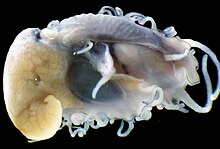Hepatopancreas
The hepatopancreas , also known as the midgut gland , is an organ of the digestive tract in various types of arthropods , molluscs, and fish . Functionally, it essentially corresponds to the organs liver and exocrine pancreas , which are developed separately in reptiles , birds and mammals , but which in these animals also emerge from a common system called the hepatopancreatic ring during embryonic development .
Construction and function

Task of the hepatopancreas that at different invertebrates one as a gland formed part of the midgut represents both the formation of digestive enzymes as well as the absorption and storage of nutrients . In various fish such as the Cyprinidae , for example , the hepatopancreas arises during larval development through the migration of the initially separately growing pancreatic tissue into the liver tissue, in which it is distributed in islands in the hepatopancreas. Many other fish species, however, have a clearly demarcated pancreas. The endocrine tissue stored in the exocrine pancreatic tissue of birds and mammals as so -called islets of Langerhans , which forms the hormones insulin and glucagon , is developed in the form of the Brockmann body in most bony fish .
In some arthropod species, the hepatopancreas is important for the bioaccumulation of environmental pollutants such as heavy metals or polycyclic aromatic hydrocarbons . This can have an impact on the corresponding food chains . The hepatopancreas of crabs , lobsters and crayfish , whose consistency is similar to that of fatty meat , is considered a delicacy under terms such as “crab butter” or “crab fat” .
Individual evidence
- ↑ GA Ahearn, PK Mandal, A. Mandal: Mechanisms of Heavy-metal Sequestration and Detoxification in Crustaceans: A Review. In: Journal of Comparative Physiology Part B: Biochemical, Systemic, and Environmental Physiology. Springer, pp. 439-452, ISSN 0174-1578
- ^ JP Meador, JE: Stein, WL Reichert, U. Varanasi: Bioaccumulation of Polycyclic Aromatic Hydrocarbons by Marine Organisms. In: Reviews of Environmental Contamination and Toxicology . Springer, pp. 79-165, ISSN 0179-5953
- ^ Paul Johnson, Karl Petzke: Fish Forever: The Definitive Guide to Understanding, Selecting, and Preparing Healthy, Delicious, and Environmentally Sustainable Seafood. John Wiley and Sons, Hoboken 2007, ISBN 0-76-458779-X , pp. 414/415
literature
- The Anatomy and Physiology of Teleosts: The Digestive System. In: Ronald J. Roberts: Fish Pathology. WB Saunders, London and New York 2001, ISBN 0-70-202563-1 , pp. 35-37
- John T. Hjelle: Digestive System. In: Gary A. Polis: The Biology of Scorpions. Stanford University Press, 1990, ISBN 0-80-471249-2 , pp. 50-52